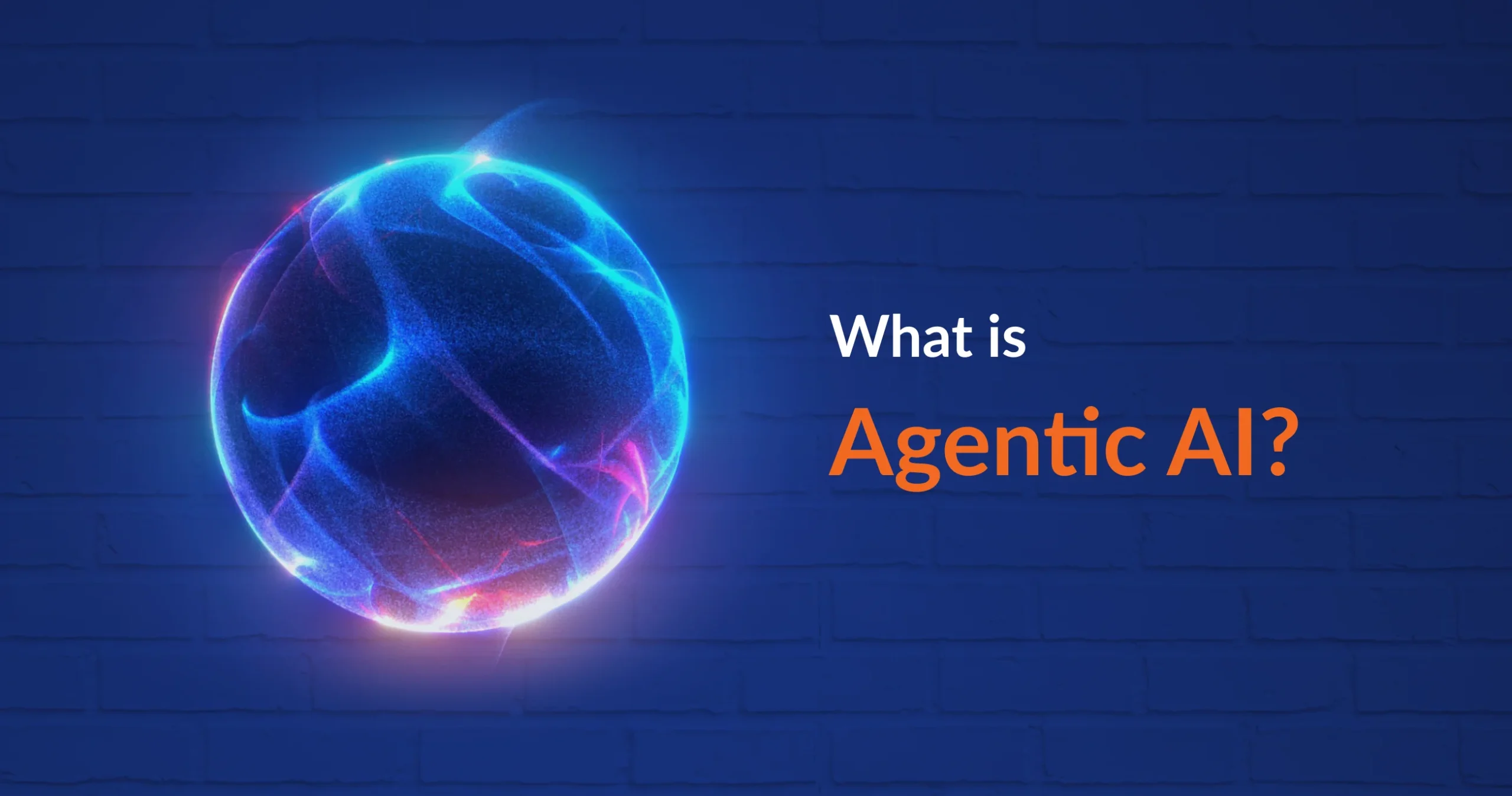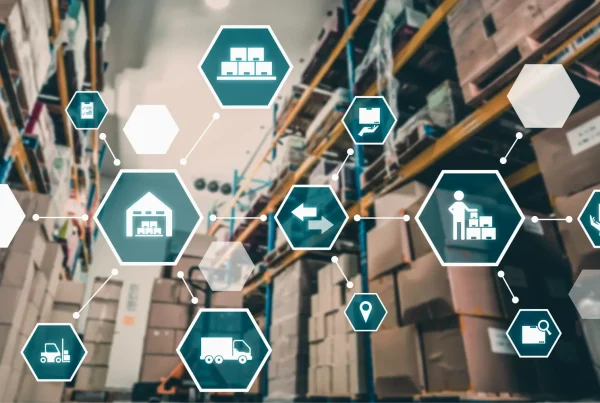Are decision-making bottlenecks and endless data analysis slowing you down? Running a business means constantly reacting to market shifts, managing complex data, and staying ahead of competitors—all while making critical decisions. But what if you could automate these processes and keep operations running seamlessly without waiting for human input?
Agentic AI is changing the game. It enables businesses to act autonomously, adapt in real time, and make smarter, data-driven decisions without manual intervention. Unlike traditional AI agents, Agentic AI doesn’t just follow pre-set rules—it continuously learns, evolves, and optimizes outcomes. In this blog, we’ll explore how Agentic AI works, what makes it different, and the key benefits it offers.
What is Agentic AI?
Agentic AI is a new kind of artificial intelligence. It goes beyond just analyzing data or offering advice. This AI can make decisions and take actions on its own. It doesn’t need constant human input to drive results.
These autonomous AI agents are built to act fast, learning from data as they go. They use advanced algorithms to find patterns, predict needs, and respond to changes in real time. The key feature of Agentic AI is its ability to perform tasks without waiting for human instructions. It is always learning and improving.
Autonomous AI can adjust its decisions based on what it learns. It changes its actions when new data comes in, ensuring the system stays up to date. Over time, AI becomes better at making decisions and handling complex tasks. It is able to correct itself and become more precise as it gathers more information.
Unlike traditional AI, which often requires human oversight, Agentic AI works independently. It can handle everything from inventory management to customer service, allowing businesses to automate routine tasks. This leads to better efficiency and more effective operations across departments.
What makes Agentic AI even more valuable is its ability to integrate into existing business systems. Whether it’s inventory platforms, customer databases, or sales tools, it can sync and improve all processes. This integration creates smoother workflows and better decision-making.
How Does Agentic AI Operate?
Agentic AI has the potential to process vast amounts of data and recognize patterns. This enables the system to make decisions on its own. It learns over time, adjusting based on new data. This continuous learning makes it smarter and more effective at solving complex problems.
Machine learning lies at the heart of Agentic AI. With each interaction, the system improves. As it gathers more data, it enhances its decision-making ability. The more the AI learns, the better it handles new challenges.
Here’s how it works:
- Real-time Monitoring: Agentic AI adapts in real time, responding to new data as it arrives. Whether it’s customer behavior or market conditions, it adjusts quickly.
- Data-Driven Decisions: The AI pulls data from various sources, like sales reports and customer feedback. This allows it to make decisions based on the most current and relevant information.
- Self-Sufficient: Once programmed, Agentic AI operates within, and without human input. For example, in retail, it can manage inventory, adjust prices, and even forecast demand.
The adaptability of Agentic AI is another critical feature. It doesn’t just follow pre-set instructions. If something changes, like a competitor lowering prices, the AI can detect this and adjust strategies immediately. This keeps businesses agile and responsive.
Different Types of AI Agents in an Agentic Architecture
Agentic architecture is made up of different types of agents. Each type has a unique role in how the AI operates and processes information. These agents are designed to interact with the environment, process data, and make decisions.
- Reactive Agents: These agents respond directly to the environment based on predefined rules. They don’t rely on complex data processing or predictions. Instead, they act on immediate conditions, like adjusting inventory when stock runs low.
- Deliberative Agents: These agents are more advanced. They analyze data and make decisions based on longer-term goals. For example, a deliberative agent might optimize stock levels for the next quarter. It predicts demand patterns using historical data and adjusts strategies accordingly.
- Hybrid Agents: Hybrid agents combine the features of both reactive and deliberative agents. They can respond to immediate conditions and make long-term decisions. This makes them highly effective in dynamic environments, where both short-term and long-term decisions matter.
- Autonomous Agents: These agents work independently. They make decisions without human intervention. They gather data, analyze it, and perform tasks, like automatically reordering products when stock falls below a certain threshold.
- Collaborative Agents: These agents work together to achieve a common goal. They share data, communicate, and make joint decisions. In retail, collaborative agents could work across multiple departments to manage inventory efficiently, ensuring that all teams are aligned in their goals.
Each agent has its strengths. Depending on the task, businesses can choose the right type to optimize their operations. The combination of different agents working together in an agentic architecture helps businesses address various challenges efficiently.
Benefits of Agentic AI
Agentic AI platform offers several distinct advantages for businesses, specifically designed to improve decision-making and efficiency. These benefits directly stem from its ability to act autonomously and make decisions in real time based on dynamic data.
1. Improved Decision-Making
Agentic AI makes autonomous decisions without human intervention, using real-time data to optimize outcomes. This eliminates human bias and delivers highly accurate, data-driven decisions that improve business operations.
2. Cost Reduction
Agentic AI adjusts processes on the fly, like inventory management, to cut unnecessary costs. By predicting demand changes and adjusting stock levels in real time, businesses can minimize waste and avoid overstocking.
3. Enhanced Efficiency
Tasks are carried out automatically, and decisions are made faster. Agentic AI enables processes to run in parallel, eliminating bottlenecks. This reduces the time spent on tasks and allows employees to focus on higher-value work.
4. Scalability
As business operations grow, Agentic AI scales seamlessly. The system adapts quickly to increasing amounts of data and complexity, ensuring operations remain efficient even as the business expands.
5. Personalized Customer Experience
Agentic AI doesn’t just analyze historical data; it acts on it to deliver personalized experiences in real time. Businesses can tailor recommendations, offers, and services dynamically, enhancing customer satisfaction and loyalty.
6. Faster Time to Market
With its ability to monitor trends in real time, Agentic AI helps businesses adjust to market changes instantly. Products can be developed, launched, and marketed faster, staying ahead of the competition.
7. Dynamic Decision-Making in Uncertainty
Agentic AI thrives in uncertainty, making decisions based on real-time data, even when information is incomplete or constantly changing. This allows businesses to adjust operations and strategies quickly in volatile conditions.
8. Autonomous Process Optimization
Agentic AI continuously monitors and refines processes. It can identify inefficiencies and automatically make adjustments to streamline workflows, leading to more effective resource allocation and improved productivity.
9. Proactive Problem-Solving
Rather than waiting for issues to arise, Agentic AI anticipates potential problems and addresses them proactively. For example, it can adjust inventory levels before stockouts or overstocking occur, reducing the risk of missed opportunities.
10. Increased Agility
Since Agentic AI can act independently and adapt to changes, businesses become more agile. It allows companies to pivot quickly, make real-time decisions, and respond faster to market shifts and customer needs.
By embracing Agentic AI, businesses gain a competitive edge. They can reduce operational costs, enhance decision-making, and become more agile and proactive in their strategies, ensuring continuous improvement and sustained growth.
How Agentic Automation Evolved to Become a Game-Changer
Agentic AI applications have evolved over decades, fueled by technological breakthroughs and changing business needs. Let’s look at the capabilities of Agentic AI.
The Rise of Machine Learning
In the 1990s and early 2000s, machine learning took center stage. AI systems began to learn from large datasets, improving over time. This laid the foundation for more complex systems. Agentic AI systems began to emerge as businesses saw the potential of using data to make smarter decisions.
Introducing Agent-Based Models
As industries grew, businesses realized they needed more advanced decision-making tools. That’s when agent-based models were introduced. These models simulate agents—intelligent entities that make decisions based on their environment. They interact with one another to predict outcomes. These models found success in industries like retail, manufacturing, and logistics, where decisions were becoming too complex for traditional systems.
Explosion of Big Data
The 2010 saw an explosion of data from e-commerce and IoT devices. This massive amount of information became the fuel for AI models. With vast datasets at its disposal, Agentic AI could now make highly informed decisions. It could forecast demand, optimize supply chains, and personalize customer experiences. Using natural language processing, Agentic AI adapts to new scenarios. This framework enhances its AI capabilities, allowing it to improve over time. It continuously learns, delivering better insights and actions across industries.
Cloud Computing Changes the Game
Around the same time, cloud computing revolutionized AI accessibility. Businesses no longer had to rely on expensive hardware to process data. Cloud services allowed AI systems to scale quickly and process vast amounts of data in real time. This boosted Agentic AI’s decision-making capabilities and made it easier to integrate into a wide range of industries.
Integration with Other Technologies
Today, Agentic AI doesn’t exist in a vacuum. It has been integrated with technologies like robotics, the Internet of Things (IoT), and automation tools. These integrations allow businesses to automate key processes, improve operational efficiency, and gain deeper insights from their data. Agentic AI can now handle tasks like inventory management, supply chain optimization, and even customer service.
The Future of Agentic AI
The evolution of Agentic AI is far from over. With advancements in machine learning, cloud computing, and data analytics, Agentic systems will continue to grow. Businesses will increasingly rely on Agentic AI to stay competitive. The future where AI extends beyond traditional use cases is near. Integrating AI into core operations will drive innovation and improve efficiency. As its capabilities expand, Agentic AI will reshape industries and redefine business success.
Ready to Take the Next Step with Impact Analytics?
Unlock the power of Agentic AI with Impact Analytics. We help businesses optimize operations, drive smarter decisions, and enhance customer experiences. Our scalable, data-driven solutions—with Agentic AI—improve efficiency, reduce costs, and boost profitability.
Whether you’re a small or large enterprise, we ensure seamless integration with your systems. Transform your business with Impact Analytics Agentic AI.
Frequently Asked Questions
What is an Agent in AI and what are its types?
An AI agent is an autonomous system that makes real-time decisions. It analyzes data, learns continuously, and takes action. Types include reactive, model-based, goal-driven, and collaborative agents.
What is an Agentic Workflow in AI?
An agentic workflow automates complex tasks using AI agents. Agents interact with systems, process data, and execute actions. They optimize pricing, inventory, and supply chain operations seamlessly.
What makes Agentic AI and Generative AI different?
Agentic AI takes actions and automates decisions. Generative AI creates content but lacks decision-making. Agentic AI integrates with business systems, optimizing operations, while Generative AI focuses on text, images, or code.
What does Agentic Workflow mean?
An agentic workflow means AI agents autonomously execute tasks. They process data, predict outcomes, and take real-time actions. This improves efficiency, reduces errors, and enhances decision-making across industries.





